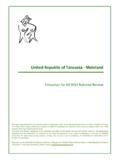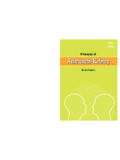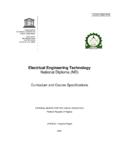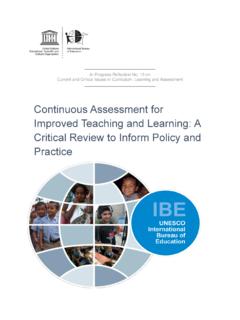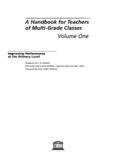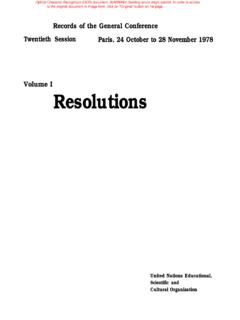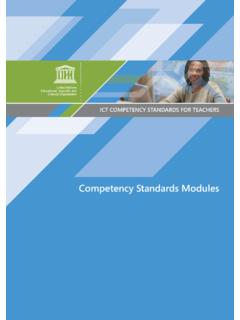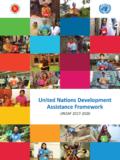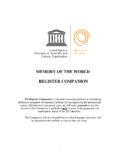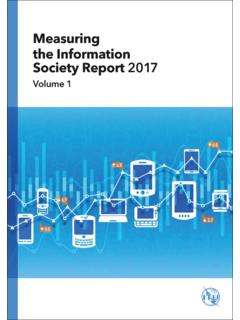Transcription of Developing and using indicators of ICT use in education; 2003
1 Developingand using indicators ofICT Use in EducationCompiled byUNESCO asia and pacific regional bureau for Education, Bangkokand Southeast Asian Ministers of Education Organization regional Centerfor Educational Innovation and Technology (SEAMEO INNOTECH)Metro Manila, PhilippinesSupported by Japanese Funds-in-Trust (JFIT)United Nations Educational, Scientific and Cultural OrganizationUNESCO BangkokSection OneStepActionDeveloping and using indicators of ICT Use in Education/compiled byUNESCO asia and pacific regional bureau for Education, Bangkok,and Southeast Asian Ministers of Education Organization regional Centrefor Educational Innovation and Technology, Metro Manila, : unesco Bangkok, EDUCATIONAL TECHNOLOGY. 2. INFORMATION COMMUNICATION TECHNOLOGY. 4. ICT. 5. COMPUTER USES INEDUCATION. 6. EDUCATIONAL INFORMATION SYSTEMS.
2 7. EDUCATIONALINDICATORS. I. unesco asia and pacific regional bureau for SEAMEO regional Centre for Educational Innovation and unesco 2003 Published by theUNESCO asia and pacific regional bureau for Box 967, Prakanong Post OfficeBangkok 10110. ThailandPrinted in ThailandThe designations employed and the presentation of material throughout the publicationdo not imply the expression of any opinion whatsoever on the part of unesco concerning the legal status of any country, territory, city or area or of its authorities, orconcerning its frontiers or 1: Introduction: indicators and Rationale of UseC o n t e n t sBasic approach to formulating indicators ..1 Section 2: using indicators to Assess Impact of ICT inEducationSynthesis of country experiences on ICT indicators and related issues .. 3 Kinds of indicators developed, based on visions or goals and surveys.
3 3 Standards for technology use .. 6 Levels of integration .. 6 ICT infrastructure, hardware and connectivity .. 7 Teacher s use of ICT .. 7 Targets of indicators surveys .. 7 Types of indicators .. 7 Assessment and evaluation methods ..10 Section 3: Methods of Collecting IndicatorsSurvey questionnaire .. 11 Telephone interview .. 113-yearly sample assessment .. 11 Internet-based surveys .. 12 Web-based self-evaluation tool .. 12 Section 4: Various Software or Database Systems for 13 Storing IndicatorsC o n t e n t s (cont d)Attachment I:ICT indicators Used in DifferentCountries ..15 Attachment II:Comparison of ICT indicator Themesin Selected Countries ..29 Attachment III: Studies on the Use and Impact of ICT in Education ..35111 SectionIntroduction: indicators and Rationaleof UseIn evaluation studies, indicators are used as evidence or signs by which we canassess or evaluate materials, methods, an intervention, a programme or a are measuring devices.
4 They define concepts in terms of themeasurements and data it is possible to collect and analyse. They define whatdata to collect and at what time develop good indicators , we need first to have a clear view of what we are tryingto achieve and to measure. The first requirement for a systematic development ofindicators for Information and Communication Technology (ICT) is to identify theresults, objectives, outputs and key concepts of the ICT project, as part of theevaluation system basic approach involves four steps:!Identify what is to be measured!Develop trial measures!Assess each trial indicator , using agreed-on criteria!Select the best indicators for a specific projectSection OneStepActionStep 1:Step 1:Step 1:Step 1:Step 1:Identify allconcepts to bemeasured,especially projectobjectives andoutputs!Review all concepts, objectives, results, and output state-ments to clarify them and reach agreement!
5 Be clear about what type of change is implied (a situation,state, condition, attitude, behaviour)!Clarify whether the outcome sought is an absolute change, arelative change, or no change!Specify where and when the change is expected (what targetgroup, what location, and in what time frame) (this identifiesthe appropriate unit of analysis)!Determine the relationship between project activities and theiroutputs or objectives (are these outputs or objectives director indirect?)Step 2:Step 2:Step 2:Step 2:Step 2:Develop a list ofpossible (trial) indicators !Think of possible alternative indicators for each concept,objective, and output, without being too restrictive!Conduct internal brainstorming sessions!Consult stakeholders and other experts!Try to borrow from other projects and studiesStep 3:Step 3:Step 3:Step 3:Step 3:Assess each trialindicator againstcriteria!
6 Establish an agreed set of criteria for indicators (see Table 2)!Use a scoring scale (1-5) to determine the usefulness of eachtrial indicator (but be flexible and use your own judgment)Table the actionsrequired in each stepStep 4:Step 4:Step 4:Step 4:Step 4:Select the bestindicators for thisproject!Consider each indicator on its merits against the criteria!Consider the mix of indicators to construct a robust set thatis consistent and complementary in terms of data-collectionmethods and time frames!Avoid having too many indicators (it may indicate that theobjectives and outputs are not clearly defined)!Be prepared to update your indicators - the best indicatorsmay change as projects develop (one common change occursafter using input indicators at first and then realizing that outputindicators were what was needed)Basic approach to formulating indicators2 Developing and using indicators of ICT Use in EducationTable 2 below summarises the criteria that can be applied in assessing potentialindicators, based on the recommendations of the Centre for DevelopmentInformation Evaluation, an institute of USAID.
7 These criteria are to be used instance, according to the Centre, direct measures are not always better thanindirect measures, while quantitative measures are not always better than process of Developing indicators involves a combination of activities, such asbrainstorming, multi-stakeholder discussions and being clear about definitions, criteria,goals and priorities. More focused and cost-effective monitoring and evaluation ofICT use in education is expected. indicators are based on assumptions aboutwhat is relevant they are expressions of value or of what is desirable. Thus, it isimportant that researchers and evaluators involve stakeholders in Developing theindicators to ensure that the data collected will respond to their information measure! indicator is intuitively understood (high face validity)! indicator is a direct measurement, rather than a proxy thatdepends on assumptions for its validity!
8 indicator is supported by a body of researchObjective! indicator is unambiguous about what is being measured!Different people will collect comparable data based on theindicator!Definition remains stable over time, so change can be measured! indicator is unidimensional (measures only one thing at a time)! indicator can be quantitative or qualitative, as long as it is clearlyand consistently defined and interpretedAdequate!Either by itself or with a minimal companion set of indicators , theindicator provides reasonable confidence that it accuratelymeasures the attribute!Object is to have as few indicators as possible per attribute (shouldbe three or fewer) - more is not necessarily better!Number of indicators will depend on the complexity of the object,or what is being measuredQuantitative!Quantitative indicators are more objective than qualitative ones!
9 Qualitative indicators should be adequately specified to be objectiveand consistentDisaggregated!The more disaggregated the indicator , the more easily data can bemanipulated to answer questions not anticipated at the outsetPractical!Data can be collected at reasonable cost, given their utility!Data are available and can be collected at suitable time intervals!Data can be readily collected in various projects for comparisonReliable! indicator is reliable within the context of the evaluation purposeand resources!Data-collection process is consistent across different time andspace scales, using comparable methods and samplingprocedures. indicator is based on representative dataTable for assessing indicators112 SectionUsing indicators toAssess Impact of ICTin Education3 3 Final ReportBelow is an attempt to synthesise several countries efforts and initiatives inconducting research to evaluate the use of ICT in education, and, for some countries,the development of ICT indicators .
10 Among these countries are:Australia CanadaCIS and Balkan countriesIndia IndonesiaJapanKorea, Republic of MalaysiaNew ZealandPhilippines SingaporeSloveniaSouth Africa ThailandUnited KingdomUnited States UzbekistanViet NamThe development or potential development of indicators in the region follows threepaths:1. Ministries of Education or the Government set up Task Forces or committees,to take charge of Developing indicators measuring the use and impact of ICTin education2. The vision and goals of the ICT programme serve as basis for the formulationof ICT indicators3. The impact of the use of ICT in education is determined through surveys andresearch and thus, serves as basis for the formulation of national indicatorsWhile the government of Korea has Cyber Korea 21 and the White Paper , thegovernment of Japan has eJapan Priority Programme and Europe has the eEurope initiative.
